Interview with Mr Hans-Kristian Bukholm | Read more at in70mm.com The 70mm Newsletter |
| Transcribed from audio files by: Margaret Weedon & Mark Lyndon. Images by: Orla Nielsen & Thomas Hauerslev | Date: 24.03.2013 |
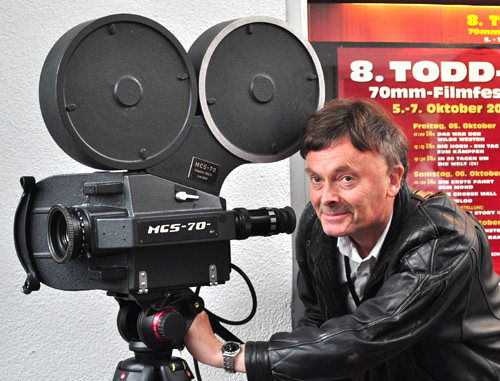 TH: Organising the 70mm Festival takes a lot of time, and the time I spent
on Hans-Kristian’s film is the same as the time I spent on this festival;
and the amount of time I spent on Paul Gerbers’s film ["Norway"
and "Symbiosis"] was exactly the same as
I spent on this film from February to now. When I first started writing for
"The 70mm Newsletter", many, many, years ago in 1995, one of my very
first articles was actually about this movie – from an
interview with Hans-Kristian, and making the credits for the film. TH: Organising the 70mm Festival takes a lot of time, and the time I spent
on Hans-Kristian’s film is the same as the time I spent on this festival;
and the amount of time I spent on Paul Gerbers’s film ["Norway"
and "Symbiosis"] was exactly the same as
I spent on this film from February to now. When I first started writing for
"The 70mm Newsletter", many, many, years ago in 1995, one of my very
first articles was actually about this movie – from an
interview with Hans-Kristian, and making the credits for the film. I am so impressed by this; I never grow too old to not enjoy just looking at incredibly sharp pictures of nice things on the screen - long enough so that you can actually enjoy them; is it not just a wonderful movie, just to enjoy its landscape, which is so beautiful! I have to say that I have seen a lot of Cinerama films lately, and the last one was “South Seas Adventure” that takes place in a hot area, and whilst this is not a "Cinerama Adventure" in Svalbard, it is certainly a “70mm Adventure” in Svalbard. There are some errors in the print of this beautiful film but otherwise the general images are perfect: although I am glad I am not there, it is too cold for me! It is with great pleasure that I introduce Hans-Kristian Bukholm: (over the last two hours he has planned everything I am going to say to him– so of course it is not improvised at all!). Congratulations with the film! It is an old film, from 1996, but it is still fresh, like a window to the world, to watch this. | More in 70mm reading: Norwegian 70mm Film Maker Attending Schauburg's Todd-AO Festival Filming of "Svalbard - Arctic Seasons" Full credits for "Svalbard - Arctic Seasons" Schauburg Cinerama, Karlsruhe, Germany Internet link: |
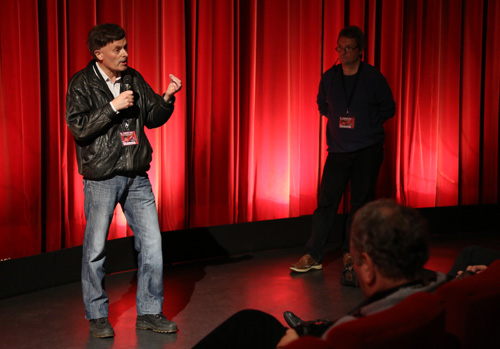 TH: What motivated you to do it like this? You have underwater – I cannot
see anyone driving a crane except bob sleighs and snow sledges - but you had
incredible pictures of ships going by through the ice – you had everything
in this film - what inspired you to do this? TH: What motivated you to do it like this? You have underwater – I cannot
see anyone driving a crane except bob sleighs and snow sledges - but you had
incredible pictures of ships going by through the ice – you had everything
in this film - what inspired you to do this?HC: Well it really started with me when I was 14 years old and I saw David Lean’s masterpiece “Lawrence of Arabia” – it is true 70mm – at a small cinema in Bergen on the west coast of Norway. I think that seeing Peter O’Toole on the camel and being able to count the grains of sand in the desert, that was a major thing for me when I decided to become a cinematographer; and at the same time I started to see all the things in Bergen that could be shot in 70mm. I had worked in photography and special effects work, matte work, process photography in the camera from the negative itself: it was before the digital age. Everyone told me - you will never be able to make a film in 65mm 70mm; how could you, you live in this little city on the west coast of a small country – and in Bergen there was almost no film production at the time; but it is a strange thing, if you have a desire, if you want to go somewhere, it seems that suddenly the opportunity presents itself. For me that opportunity arose when I met a Russian colleague and she confirmed, what I knew from before, that they were making a lot of feature films in 70mm in Soviet Russia and this was the time when the Soviet Union was more or less falling apart. In a year or two I managed to get hold of two small and extremely compact 70mm cameras. They had been constructed for the use in military aeroplanes but some of them had also been used by Sergei Bondarchuk when shooting his big film “War & Peace” in the ‘60s. So a couple of days after Gorbechev was overthrown these two cameras were brought (I would not use the word smuggled) from Moscow to Oslo, and we started work on modifying them because the Russians used 70mm wide negative and in the West we used 65mm. We had to modify the field gate and the gripping system of the camera, and when we had done that I was contacted by the man who became the producer and co-director of this film – Carl E Johannessen– a very good friend of mine. - (he asked me a couple of days ago to bring his greetings to you here today). | |
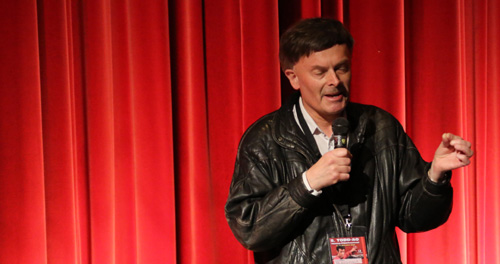 The Nansen Environmental Centre in Bergen were doing research into sea and
wind and the atmosphere, and often had visitors from other parts of the
world, and they did not have anything to show to them. The director had
contacted the Showscan Corporation and
IMAX in the States and he realised
that every minute of an IMAX film would cost more than one million Norwegian
kroner and, for a small scientific institution, that would be impossible;
thus we had just modified those two small Russian cameras - and we had some
talks with Showscan. The Nansen Environmental Centre in Bergen were doing research into sea and
wind and the atmosphere, and often had visitors from other parts of the
world, and they did not have anything to show to them. The director had
contacted the Showscan Corporation and
IMAX in the States and he realised
that every minute of an IMAX film would cost more than one million Norwegian
kroner and, for a small scientific institution, that would be impossible;
thus we had just modified those two small Russian cameras - and we had some
talks with Showscan.But a Showscan camera moving 60 frames per second would weigh 50 kilos and we were supposed to shoot with a very small team and I could not imagine the service technician that the Showscan Corporation insisted on sending along with us would sleep in a tent at 12 degrees below zero. So we skipped Showscan and decided only to use those two small cameras with only two minutes in every magazine of film, which was favourable because we could not afford to shoot very much film; in fact we shot one hour and fifty minutes of film. I think what saved us was exactly that we had two small cameras with no electronics at all; my experience is that electronics do not work under such harsh conditions and living in a tent we had to spend one or two hours every night to lubricate the cameras mechanisms to make sure every apart every screw was oiled, and because we were driving snow scooters with vibrations all the time, there was a lot of work to ensure that the all the screws and parts did not fall apart. We had some time lapse sequences, we wanted that because it is so impressive on the big screen, and we contacted Arnold and Richter in Munich; but we could not afford the sum they wanted to charge for lending us their time lapse animation system. So the solution was to go to a car demolition company outside Bergen, and I bought a window wiper motor for a Toyota Hiace, an old car, and that became our time lapse motor system, and it worked perfectly all the time in 30 degrees below zero. This is really a low budget film made from equipment modified at the kitchen bench actually. The Nansen Centre wanted a big film for the big screen – not a small TV screen - and we wanted very much to demonstrate that we could make some kind of a film and we had good luck, the weather was good; we had no technical problems at all with these small very rugged Soviet cameras. | |
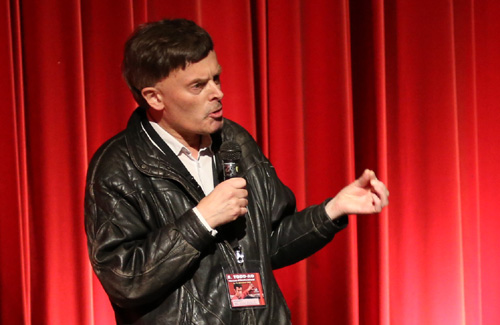 TH: Could you tell us about what lenses you used? The picture is so sharp
and crisp we could almost feel the icebergs: TH: Could you tell us about what lenses you used? The picture is so sharp
and crisp we could almost feel the icebergs:HC: We had two cameras; we had 12 lenses all together, and they were different kinds of makes – Nuvo, and some Russian words I could not pronounce, and I was very sceptical working with these lenses; but when we took one of them apart and removed the name Nuvo - we could find parts inside lens mechanics which showed that they were made by Carl Zeiss!! So we ran our own tests and they proved to be absolutely excellent. Some of the lenses are 1.4 which is very rare and when we looked at the movement, the gripping system, it was an exact copy of a Mitchell camera – and as can be see the picture is very steady; so we had no problem with these small cameras. The way it was filmed with two minutes of film, and a reflex viewfinder system, 9.5 kilos for one camera; this is about the same as a video camcorder of today. Without these two very small and very rugged cameras, I do not think we could have made this film at all - because a big crew, say 15 or 20 members of a Showscan team, would probably demand helicopter transportation back to the hotel every night, and that we could not have afforded. Also, we did have a lot of luck. | |
|
TH: – Did you attach modern lenses to the camera as well? HC: Yes, we also used a Solar Pentax medium format camera at 35 and 105, and for the telephoto shots of polar bears we used a Hasselblad Carl Zeiss - lens 250mm – it proved to be an excellent choice. It gave us the intensity of the closeness of them TH: Did you have an airplane certificate? - since I saw in the credits the photographer, you, took the pictures - or did somebody else fly the airplane? HC: Usually we would want to rent a helicopter but we could not afford it, so the solution was an old one - you could see the shadow of the airplane in some of the shots; it was a one engine Cessna and many years ago it had been modified by the military to shoot pictures from the air so the wings were strong and built to carry a camera; the Norwegian air authorities accepted the 65mm camera mounted underneath the wing – so we didn’t have to argue with them for that, which was good since we would not have wanted to argue with them about that. The pilot was an excellent guy, Arvid Hausgård, he had been a pilot in Malaysia - taking off and landing on small airports in the jungle - and he proved to be an excellent choice. I have flown with young pilots many times and they want to show you what they can do! they go up and down, and you cannot get a single steady shot; but Mr Hausgård was excellent; he understood that for the big screen you had to move smoothly – keep the plane steady. Again, we had good luck; he asked me if I wanted to go with him in this plane from Bergen to Svalbard, an 11 hours flight. I said yes, of course, and then, as we were about to take off from Bergen airport, he gave me one of those watertight survival suits; He said, well you see Hans, we have only one motor, so if we have problems between Norway and Spitsbergen Svalbard, it is a four hours flight over open sea; if we have to land on the sea then you should not leave the aeroplane before the water level reaches the wing;. I looked around and noticed the wing was about half a meter above the roof level of the cabin!! So at that point I started looking around to see if we could use the Scandinavian Airways Systems instead, but it was too late! So we flew up there, and the weather was good; we were very lucky! It does depend on luck, of course, I prefer to tell you how clever I am, but we had lots of luck; when we came up we had the first clear day for four weeks; the next day it was clear on the west coast, but cloudy near the city; so we flew over there, and we took some pictures; on the third day we shot on the east coast because it was clear there; and on the fourth day we left Svalbard as planned at 11 o’clock: at 12 o’clock there was snow and fog, and I suppose if we had not left when we did we would have probably had to stay there for several weeks!! Of course I was very nervous as we had not had any opportunity to test the cameras and we were shooting under very difficult conditions. The shooting lasted for four months – shooting winter pictures and spring pictures in May, and summer pictures of the birds, and so on, in summertime, and at the island – Hope Island – an ecological station, we shot the polar bear sequences; luckily we did not have any problems with the cameras. | |
 TH: I think it is good you can actually see the shadow of the aeroplane on
the glaciers because it gives you a better idea of the size of everything
around you. TH: I think it is good you can actually see the shadow of the aeroplane on
the glaciers because it gives you a better idea of the size of everything
around you.HC: yes, if you could not have seen the shadow of the plane it would have been harder to see the size of the landscape that is all around you. TH: You filmed one hour and 50 minutes of 70mm film, where did you go with this film – where do you go to have it developed, edited, sound checked? HC: well it could not be developed locally since they were busy enough developing all the 16mm and 35mm – so we had to go to Technicolor London; and that was quite an experience. They pulled out much of the old equipment that they did not use anymore and the day they made the first print in 70mm, I mentioned that Freddie Young inspired me to do the film, that Freddie A. Young had shot the sand sequences for "Lawrence of Arabia", and that is how I was inspired to shoot landscapes. Then Keith Bryant, who worked at Technicolor for many years, told me that Freddie Young was still alive; he was 94 at the time – so I wrote to him and I must admit I went one more time to London to be able to meet the legendary Freddie Young. He and his wife Joey invited me for dinner. So Freddie Young, who got his first Oscar for "Lawrence of Arabia", was actually the first one to see the first print of “70mm Svardbard” – and for me that was the greatest experience. TH: All the negatives, and sound, and recording - that was all done in London? HC: Yes at Pinewood Studios. TH: Did you do all the work, or did you have people to assist you? HC: No, of course the sound track was done by a Norwegian - Jan H Lindvik – he was experienced having made several sound tracks for important feature films, worked for Orion, etc., so he knew exactly what he was doing. But the final mix had to be done in London. TH: Tell us about the premier of the film, where did that take place? HC: At the time we had no cinema in Bergen capable of showing 70mm so we had to bring it to the Coliseum in Oslo. They had two DP70 projectors – it was shown to 900 persons, four times actually. After that, we managed to get hold of a DP70 (similar to the one behind here); we built a small cinema in Bergen and showed the film on a curved screen twice a month for special invited guests. TH: The famous 70mm film that inspired you – “Lawrence of Arabia” – do you have any other films that were your favourites? HC: I think that “Lawrence of Arabia” was perhaps the best film ever shot in 65mm or 70mm, and that is because of the direction of David Lean and the marvellous cinematography of Freddie Young. I cannot imagine a film better made and of course the marvellous way they had of shooting the desert. TH: I must interrupt you now because we have this morning found out that Hans is not a Norwegian – he was born in Denmark – so he is essentially a Danish film producer. HC: Of course in today’s blinkered world, 70mm is fading away; we now have cameras shooting 4K and in a couple of years we will have cameras shooting 8K - very high resolution, but my friend and colleague – Morten Skallerud - who made "A Year Along the Abandoned Road" told me that to get all the picture quality out of a 65mm negative you need 12K. So I did not think I was going to use my two cameras any more. But this spring I managed to get hold of one and a half hours of raw stock 65mm at a price below 35mm; It is in the basement of my house; so I told Thomas about a new idea I had been working on for several years; a film ["Av Hav", ed] with dancers against a background of the waves of the North Sea in wintertime and, if we manage to make it – (it is very difficult because Norway is a very small country and if you mention 70mm in Norway they look at you and think you are crazy, and they are probably right!) – we will be very happy! I hope perhaps it will be possible to get in touch with someone in Europe or America to back it up. In which case we will have a short film lasting 12 minutes shot on 65mm negative ready in a couple of years and that may very well be the last film shot in 65mm in Europe, ever! | |
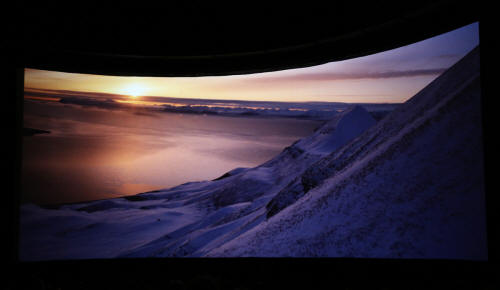 TH: And now we shall ask the audience if they have any questions: TH: And now we shall ask the audience if they have any questions:Question 1 – (Mark): You were in charge of the aerial photography according to the credits – and I would say that this is the best Arctic aerial photography ever achieved in the history of cinematography; and it certainly stands alongside Paul Mantz’s aerial cinematography in “This is Cinerama”. What was the most difficult part in setting up the aerial shoot? You had a Cessna aircraft rigged for the 70mm Russian camera, but what was the hardest part of getting that footage – capturing those images? HC: We had video assistance; a small black and white camera beside the camera, so it was inside the cabin - pushing the buttons and stopping and starting the cameras - although the main problem was when taking off from Svalbard airport in Spitzbergen we could not see from the cabin if there was ice condensing on the lens surface so in one of the shots you may see some blurring on the right side of the picture. We suspected we had some problems so we flew around for 30 minutes and then it would disappear. It only happened once because of a temperature change. Besides, of course, we never knew what we had got because I sat in the cabin I did not have a clear view ahead; so I had this very small black and white screen to tell me what was actually going into the camera. But we did not have any problems - we could shoot a very low amount of film because of this excellent pilot who knew exactly what he was doing. (Mark) - Well congratulations on a master piece – especially the last shot which had the sun set in the distance, the depth of focus, everything, was one of the finest achievements in the history of cinema. HC: I should just like to add - I have seen people flocking around the 70mm camera here in the cinema, and from time to time I have had a feeling that people were worshipping the picture of the Christ or something! but one should bear in mind that the 65mm camera is a marvellous tool; but it is a tool that needs a great operator, and if you operate it in the correct way then you can create marvellous sharp, bright and colourful pictures when put together will form a unity that will make some kind of impression, and give the audience an experience. The format does not mean anything by itself - it is what you can use it for; use it to do something sensible to create something to give to other people. HC: So I am looking forward to the new high definition, really high definition, and I do not talk about TV high definition, this is really young definition, but in the future I think that cinematography will reach perhaps the same level as 65mm in the past, and I am really looking forward to that because shooting in 65mm negative is extremely expensive, so you cannot push the button unless you know exactly what you are doing; unless know exactly that the composition is right. And I know that shooting in 65mm brings a new discipline to me – with a digital camera you can let it run, and run, and just delete it afterwards on the tape or the memory card; but shooting in 65mm means that you have to know exactly what you are doing. HC: I want to congratulate you – you all know of the 65mm camera in the house here – and I hope that one day you will make a good film with it!! And I should like to thank you for the good reception you have given me. | |
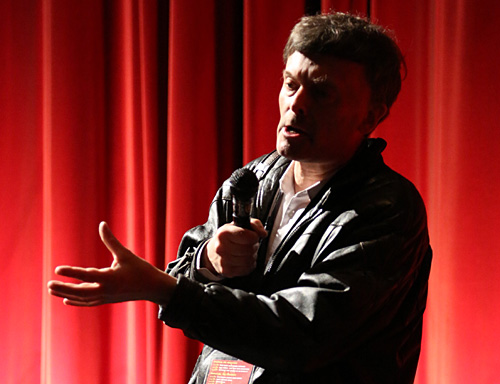 Question 2: Question 2:There is the question of the modification of the Russian camera, because the perforations are different in Russia than they are in the western world. How was that done? HC: We were very lucky because I knew a veteran mechanic; he had been working in cinemas in Norway for many years – he is 87 now and is still working for me from time to time; he spent several weeks modifying the film gate making use of the parts inside – the Russian camera used 70mm negatives with the print kind of perforation holes at the edges and the west produced a 65mm negative with the same shape perforation holes as the 70mm negative, which is not the same; so we had to do a lot of work modifying the gate and the rake pins for the new operation; and that is what really made me nervous because it was very difficult, and I received the camera from the repair shop in Oslo the evening before we were leaving for Svalbard and so we could not run any tests; so I was shooting without knowing if anything worked. But fortunately it did. | |
|
Question 3 What about the missing minute? – we were told that this was the short version; there was one more minute somewhere? HC: The print you saw here today is the short version. We were using the film in Bergen for several years and it was beginning to be dirty and scratchy; so we took the two copies of the print to Gulliver in Paris to clean them – and whilst they were cleaning the second print they had a mechanical breakdown – so the interior sequence in the hunter’s cabin was ruined; thus there is a rather harsh and ugly cut in the film relating to the snow house – so the film is almost the same but one sequence of about one minute is missing: TH: What happened in the snow house? HC: Well there were just some people trying to keep warm, lighting a fire – looking at pictures of naked women – the most popular thing!! TH: So it must have been the censored version.. | |
 Question 4 Question 4Was the ice bear in the movie from the Zoo? HC: No, we spent four months shooting the film all together and I made notes; during that period we could see at a distance, and from very close to, at least, I think, 56 different polar bears – so it became kind of a habit. But I have seen polar bears many times on TV, what I did not know was the formidable size of the things – the biggest polar bears weigh from 400 to 600 kilos. It can move at a speed of 40 km per hour over short distance; and it is also one of the very few animals on the planet that actually eats human flesh, so I must admit sitting behind a camera having a polar bear at ten meters – and knowing that it was a question of a very few seconds - you cannot predict what a polar bear is going to do from its behaviour – so even if I had a man behind me with a rifle I did not feel quite safe! I did not realise that if a large polar bear is standing beside you on its four feet, its head will be at the correct height to lick your ear, but I think it would not be only the licking, it would take the rest as well. So that was a nerve breaking experience really – I have a lot of respect for the Arctic after this production. HC: It also gave us some marvellous experiences because we were working for a scientific organisation - the Nansen Centre in Bergen who are doing research in the Arctic and we had the opportunity to use the snow scooters into the national parks, and I do not think it has been done before; so it was a marvellous experience in cinematography to film in this way; and of course shooting in 65mm with that extremely high resolution, that was an experience in itself. TH: Were they pleased with the film when they saw it, the men who commissioned you to do it? HC: Yes, I saw the director of the Nansen Centre just a couple of months ago; they told me that he had said it is the best Arctic film he has ever seen; and I am very happy about that, because when you are starting with two old Russian cameras, and you have never made a film in this format before, you cannot afford to do anything wrong – with exposure or composition - when you are shooting in 65mm. You have got to get it right the first time; that really is something for a cinematographer coming from a small city on the west coast of Norway, never having done this before, and of course the reaction means so very much. With thanks - October 2012 | |
| Go: back - top -
back issues -
news index Updated 22-01-25 |
